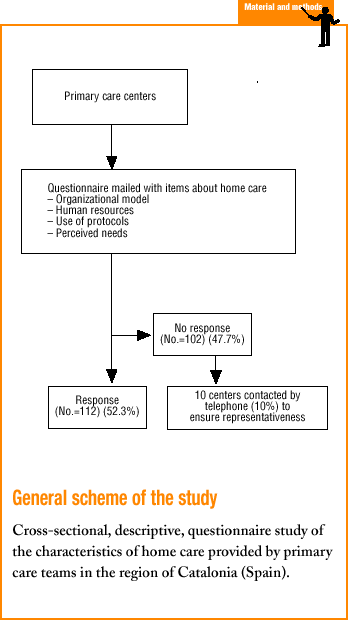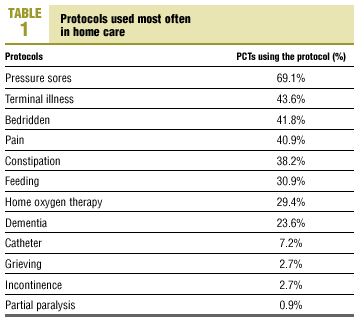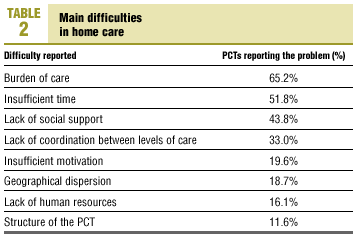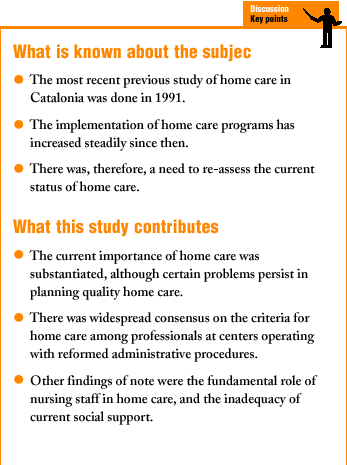Introduction
The growing importance of home care, as a result of the steady aging of the population along with improvements in the diagnosis and treatment of chronic diseases,1,2 is leading to ever-greater human and material resources being devoted to covering the demand. It is important to estimate the burden of care this type of service can involve for primary health care teams (PCTs) both in terms of the patients´ individual characteristics3,4 and in terms of population-based prediction models.5
Since the recent reforms in the Spanish public health system came into effect, home care has become the responsibility of PCTs. Although other professionals have joined the support staff in some autonomous communities (as in the PADES teams, which provide home care in the region of Catalonia), most home care continues to be provided by primary care professionals.
One of the difficulties in home care is in the definition of the term itself, which is not based as is usual among physicians on a specific disease, but arises instead from biopsychosocial circumstances, i.e., the patient´s inability to leave the home. This may be the reason why home care varies depending on the disease, social circumstances or emotional state of both the patient and the care provider.
Many studies have been done in the last 10 years to evaluate home care programs or specific protocols (for patients with dementia or pressure sores, or care for the care provider); however, fewer studies have looked at the degree of implementation of programs, the most widely used types of assessment instrument, or the difficulties professionals encounter with home care.
To characterize the current situation, the Home Care Group (ATDOM, in Spanish) of the Catalonian Society of Family and Community Medicine undertook a study aimed at updating the results of an earlier survey carried out in Catalonia in 1991, and published by Lacasa et al in 1993.6 The aim of the present study was to determine the degree of implementation of a home care program by different PCTs in Catalonia, in terms of the organizational model, involvement of different professionals, use of protocols for specific problems, assessment instruments, and internal and external resources. A secondary aim was to note the obstacles different professionals identified to appropriate implementation of the program. Surveys such as that reported here can help elucidate the current status of home care programs in our setting, and can provide data for different provinces, population densities and PCT characteristics.
Material and methods
The ATDOM Group of the Catalonian Society of Family and Community Medicine (SCMFiC, in Spanish) designed a cross-sectional, descriptive study to obtain information on the organizational model, resources and implementation of home care programs in primary care provided through the Catalonian public health service in 1999.
A semistructured, self-administered questionnaire was prepared and approved by the Communications Group of the SCMFiC. The questionnaire contained items on the center, human resources, organizational model of the program (time, responsibilities of different professionals, continuing education in home care, number of patients covered), variables related to the degree of standardization of home care (types of protocols for specific problems, instruments used to measure autonomy, cognitive status, and pressure sores), and needs perceived by health professionals for the appropriate implementation of the home care program.
The questionnaire was mailed to 214 reformed primary care centers (PCCs) operating in Catalonia, which were identified from a list maintained by the SCMFiC. The questionnaire was accompanied by a cover letter that explained the aims of the study and gave basic instructions to enable the head of the home care program or the director of the PCC to complete the survey correctly. Completed questionnaires were to be returned by mail to the SCMFiC offices. The results of the survey were collected during July to November, 2000. Of the 214 PCCs that received the questionnaire, replies were received from 112 (52.3%). It is important to note here that items on the questionnaire referred to the home care program that was in operation in the year 1999.
The data were imported into a database and analyzed with version 9.0 of the SPSS. Chi-squared tests were used for qualitative variables. Student´s t test and analysis of variance with Scheffe´s test for comparison of the means were also used. For most cases the significance level was set at α=0.05. To ensure that the sample was representative, 10% of the PCCs that did not return the questionnaire were contacted by telephone to obtain their responses; no significant differences in the responses were found between this group and the group of centers that returned their questionnaire spontaneously.
Results
The response rate was 52.3%, distributed by province as follows: 71.8% Barcelona, 12.7% Gerona, 9.1% Lerida, and 6.4% Tarragona. In proportional terms the province with the highest response rate among PCCs was Gerona: 73.7%. Of all PCCs that responded, 66.4% were urban and 33.6% were rural. Three-fourths (75.9%) of the centers are administered by the Catalonian Institute of Health and 24.1% by other organisms. Non-teaching centers predominated the sample (69.7% vs 30.3% teaching centers). The average number of basic care units per center was 9, and centers had been operating for an average of 8.4 years.
Most centers (90.2%; 95% CI, 84.7%-95.7%) offered home care, and mean duration of the programs was 5.6 years. The staff members responsible for the program were nurses (53.3%), physicians (20%), both (11.1%), or other professionals (15.6%). Nursing staff members devoted twice as much time to the home care program per week (5.09 h) as did physicians (2.85 h) and social workers (2.65 h). Computerization of the data from the program was 31.3%; this figure was significantly higher in Gerona (51%; P<.05) and in privately-run PCCs (70%; P<.05).
Additional resources used for the program were also studied. A social worker was included in the team at 70% of the PCCs, and a home care nurse at 13%. More than 60% of the programs were assisted by a home care support team (PADES project). Home care was coordinated with social service centers at 50% of the PCCs, and with interdisciplinary health and social service centers (UFISS, in Spanish) at 32% of the PCCs.
Most centers (79.5%; 95% CI, 72.1%-86.9%) used specific protocols. The most frequently used protocols were those to evaluate the risk of pressure sores (69.1%), terminally ill patients (43.6%), bedridden patients (41.8%) and pain (40.9%) (Table 1). Protocols were used more often (P<.05) by teaching centers (91.2%; 95% CI, 85.3%-97%).
For the overall assessment of patients, the scales used most often were the Barthel index (73.2%) for the degree of autonomy based on daily life activities, the Mini-Mental State Examination (MMSE) for mental state (73.2%), and the Norton scale (53.6%) for the risk of pressure sores. Other scales of interest were used to assess degree of autonomy (Katz instrument, 17.9%; OARS instrument, 7.2%), mental state (Pfeiffer SPMSQ, 30.4%; Set-test, 10.7%, informant´s tests, 3.6%), and to assess the risk of pressure sores (Braden scale, 21.4%; Arnell scale, 2.8%).
Continuing education in home care was provided at 66% of the centers, and more than 75% offered training for care providers on topics such as risks in the home (68.6%) and caring for the care provider (59.2%).
When primary care health professionals were questioned about the main difficulties (Table 2) they saw in running a home care program at their center, 65.2% noted the burden of care, 51.8% noted insufficient time, 43.8% mentioned inadequate social support, and 33% cited lack of coordination with other levels of care.
Discussion
This study set out to analyze the current status of home care in Catalonia. Although the number of centers that responded was only slightly over 50%, we feel this response rate to be acceptable for a questionnaire of the characteristics described here. Moreover, representativeness of the study was verified by the lack of differences in responses between PCCs that responded spontaneously and centers that did not.
The home care program is a necessary instrument to allow PCTs to provide appropriate home care in an organized manner.7,8 Such care requires an awareness of all available resources,9,10 and periodic evaluations of the objectives defined previously during analysis of integral care for homebound patients.11-16 In this connection we emphasize the considerable increase in the implementation of the home care program6: currently 90% of all centers surveyed use the program in the course of the center´s normal daily activities, with nursing staff responsible for the program at more than half of the centers. Nursing staff currently devote more than twice as much time to the program as other professionals (physicians or social workers). In addition, programs such as the «Health at Home» (Salut a casa, in Catalan)17 project, recently piloted in the city of Barcelona, should serve to further extend the home care program by enhancing the role of nursing staff. Specific protocols were used at most centers (almost 80%), and were more widespread at teaching than at non-teaching centers.
Computerization of the data, now at about 30%, clearly needs to improve, especially at publicly-administered centers. Our survey findings show that although joint programs for implementing home care programs do operate, coordination between different levels of care needs to improve.
Continuing education in home care is fundamental, and although more than half of the centers we surveyed provided such training (66%), we feel it should form part of periodic training activities at all PCCs. Most continuing education efforts are aimed at preventing risks in the home,18,19 and at providing adequate support for the care provider.20 Earlier studies21-23 have reported physical problems such as repetitive stress back pain and lower back pain, as well as psychiatric problems such as alterations in the Goldberg anxiety and depression scales,24,25 especially when the care provider is a relative.26,27 In addition, appropriate assessment28-31 of autonomy and cognitive function is important in homebound patients, as age-related physical and mental impairments have been associated with greater psychiatric distress of the care provider.26 Invalidity in a family member is a potential source of stress within the family;27 the increased anxiety can increase the use of psychotropic drugs32 by both disabled patients and their care providers.33
The results of our survey show that the instruments used most often in Catalonia for the integral assessment of patients are the Barthel index for degree of autonomy, the MMSE to measure cognitive function, and the Norton scale for the risk of pressure sores. To assess autonomy the Barthel test (more useful in patients undergoing rehabilitation) has become more widespread than the Katz instrument, which is also a good predictor34 of the frequency of visits to the doctor and patient survival and institutionalization. Also noteworthy is the use, as a second choice, of brief tests such as the SPMSQ to measure cognitive function.
As noted earlier, we consider the number of centers that participated in the survey (slightly more than 50%) to be acceptable in a study of this nature. Although the response rate probably is not a limitation in the present study, we cannot rule out selection biases. To ensure that the sample was representative, we contacted 10% of the nonresponding PCCs by telephone to obtain their responses to the questionnaire, and found no differences in the results between responding and nonresponding centers. Because the questionnaire was self-administered, this obviated the possibility of information bias caused by low interobserver reliability.
On a final note, we emphasize that the main obstacles professionals identified here were the well-known problems of heavy burden of care (which leaves less time for home care than would be desirable), insufficient social support, and inadequate coordination between levels of care. We hope that substantial changes will come about that will allow efficient progress35 in overcoming the obstacles that primary health care professionals in Catalonia have identified so clearly.
* J.I. Aóiz Linares (ABS Santa Perpetua de Mogoda), A. Aranzana Martínez (CAP Montcada i Reixac), P. Babi Rourera (ABS La Pau), R.B. Muñoz Muñoz (ABS La Salut), I. Castellá Dagà (ABS Girona-2), F. Cegri Lombardo (ABS Vía Barcino), I. Gónzalez Diaz (ABS Morera-Pomar), M. Guerrero Gancedo (ABS Raval Sud), S. Lancho Lancho (ABS Raval Nord), E. Maroto Martínez (ABS Sant Martí), M. Marsà Carretero (ABS Raval Nord), N. Martí Guadaño (ABS Raval Nord), A.M. Pérez del Molino Cucurny (CAP Les Corts) and J.M. Segura Noguera (ABS Raval Nord).
Correspondence: Grupo ATDOM, Comisión de Investigación Sociedad Catalana de Medicina Familiar y Comunitaria, C/ Portaferrisa, 8, pral, 08002 Barcelona, Spain. Correo electrónico: jseguran@meditex.es
Manuscript received 4 April 2002.
Manuscript accepted for publication 21 October 2002.















